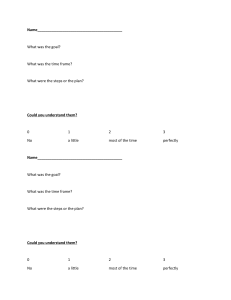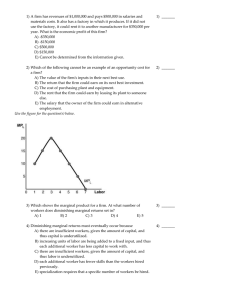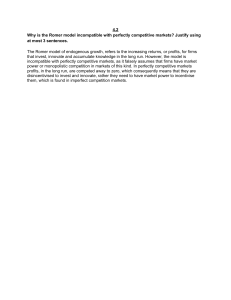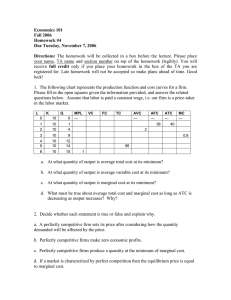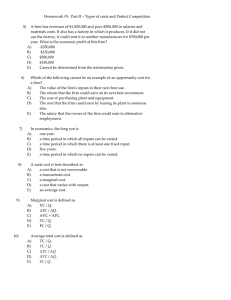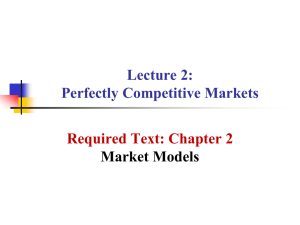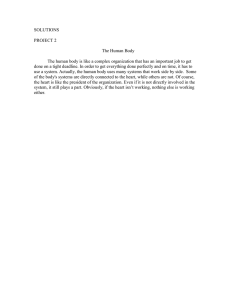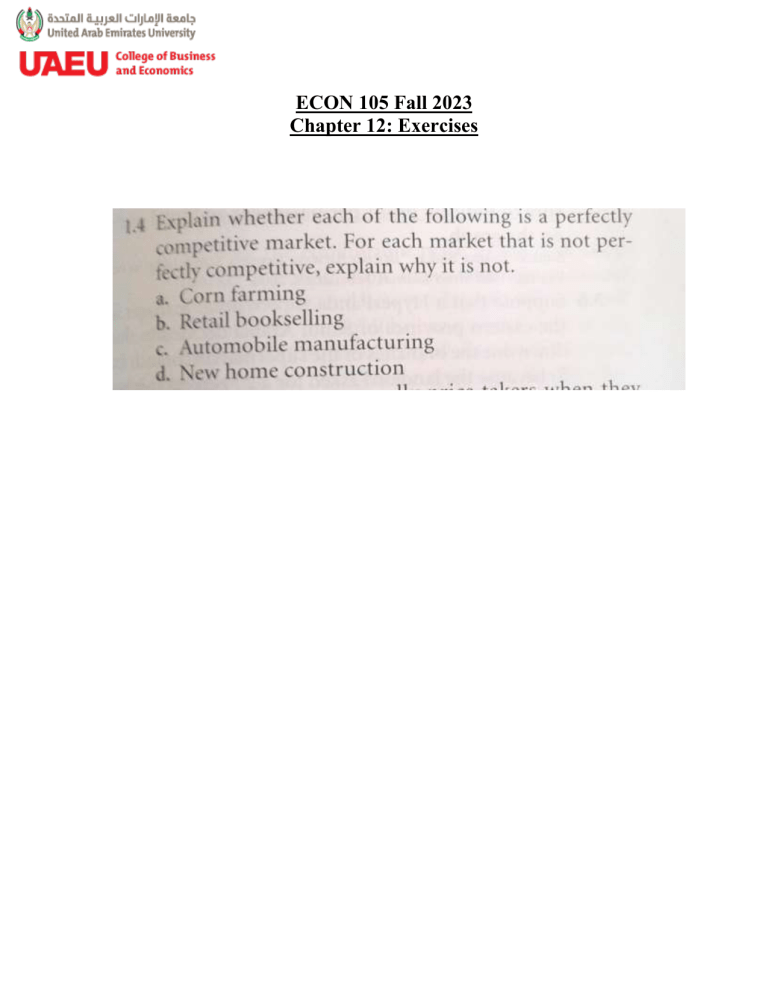
ECON 105 Fall 2023 Chapter 12: Exercises MCQ: 1) Which of the following is not a characteristic of a perfectly competitive market structure? A) There are a very large number of firms that are small compared to the market. B) All firms sell identical products. C) There are no restrictions to entry by new firms. D) There are restrictions on exit of firms. 2) A very large number of small sellers who sell identical products imply A) a multitude of vastly different selling prices. B) a downward-sloping demand for each sellerʹs product. C) the inability of one seller to influence price. D) chaos in the market. 3) Both individual buyers and sellers in perfect competition A) can influence the market price by their own individual actions. B) can influence the market price by joining with a few of their competitors. C) have to take the market price as a given. D) have the market price dictated to them by government. 4) Jason, a high-school student, mows lawns for families in his neighborhood. The going rate is $12 for each lawn-mowing service. Jason would like to charge $20 because he believes he has more experience mowing lawns than the many other teenagers who also offer the same service. If the market for lawn mowing services is perfectly competitive, what would happen if Jason raised his price? A) He would lose some but not all his customers. B) Initially, his customers might complain but over time they will come to accept the new rate. C) If Jason raises his price, he would lose all his customers. D) If Jason raises his price, then all others supplying the same service will also raise their prices. 5) Which of the following arguments could be made as evidence that the market for produce sold at a farmersʹ market is perfectly competitive? A) The U.S. Department of Agriculture has established standards for the labeling of organic produce sold at farmersʹ markets. B) Sales of organically grown food have increased at a rate of 20 percent per year. C) As more farmers began selling their products at farmersʹ markets, the increase in supply has driven down prices to the point where they just cover the cost of production. D) The profits earned by farmers who sell their products at farmersʹ markets have continued to grow, despite the increasing number of farmers entering this market. 6) Which of the following is not an assumption of perfectly competitive markets? A) There are many sellers and many buyers, all of which are small relative to the market. B) Each firm produces a similar but not identical product. C) There are no barriers to new firms entering the market. D) The products sold by all firms in the market are identical. 7) Firms in perfect competition are price takers because A) one firm determines the price that all other firms in the industry will charge. B) consumers have enough market power to set prices. C) firms accept the price determined by the government. D) each firm is too small relative to the market to be able to influence price. Figure 12-2 8) Refer to Figure 12-2. What is the amount of profit if the firm produces Q2 units? A) It is equal to the vertical distance c to g. B) It is equal to the vertical distance c to Q2 . C) It is equal to the vertical distance g to Q2 . D) It is equal to the vertical distance c to g multiplied by Q2 units. 9) Refer to Figure 12-2. Suppose the firm is currently producing Q2 units. What happens if it expands output to Q3 units? A) Its profit increases by the size of the vertical distance df. B) It makes less profit. C) It incurs a loss. D) It will be moving toward its profit maximizing output. 10) Assume that price is greater than average variable cost. If a perfectly competitive seller is producing at an output where price is $11 and the marginal cost is $14.54, then to maximize profits the firm should A) continue producing at the current output. B) produce a larger level of output. C) produce a smaller level of output. D) There is not enough information given to answer the question. 11) If a perfectly competitive firmʹs price is less than its average total cost but greater than its average variable cost, the firm A) is earning a profit. B) should shut down. C) is incurring a loss. D) is breaking even. 12) All of the following can be used to compute average profit except A) marginal profit minus marginal cost. B) total profit divided by quantity. C) average revenue minus average total cost. D) price minus average total cost. 13) If price = marginal cost at the output produced by a perfectly competitive firm and the firm is earning an economic profit, then A) marginal revenue is less than price. B) average total cost is at a minimum. C) total revenue equals total cost. D) price exceeds average total cost. Figure 12-9 shows cost and demand curves facing a profit-maximizing, perfectly competitive firm. 14) Refer to Figure 12-9. At price P1 , the firm would produce A) Q1 units B) Q3 units. D) zero units. C) Q5 units. 15) Refer to Figure 12-9. At price P1 , the firm would A) lose an amount equal to its fixed cost. than fixed cost. C) lose an amount less than fixed cost. B) lose an amount more D) break even. Figure 12-11 16) Refer to Figure 12-11. Suppose the prevailing price is $20 and the firm is currently producing 1,350 units. In the long -run equilibrium, the firm represented in the diagram A) will continue to produce the same quantity. B) will reduce its output to 1,100 units. C) will reduce its output to 750 units. D) will cease to exist. Figure 12-19 21 / Refer to Figure 12-19. The figure above shows the cost curves of a perfectly competitive firm in the coffee market. Use the graph in Figure 12 -19 to answer the following questions. Assume the market price is $3 per pound. a. What is the lowest price at which the coffee grower will supply output in the short run? b. In the diagram draw the firmʹs demand curve (label this ʺ MRʺ for marginal revenue). c. What is the firmʹs profit-maximizing output? d. Is the firm earning a profit or a loss? Identify the area in the graph that represents the firmʹs profit or loss. e. Explain how entry or exit will occur in the market to ensure that firms will break even in the long run.
